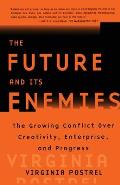 by Virginia Postrel
by Virginia Postrel
The Future, argues Virginia Postrel, is not static. It’s not discovered, it’s created.
The Clinton Administration sought to capture the public imagination about the future by alluding to the grand engineering projects of the past. “Bridge to the Future.” “Information Superhighway.” “Stairway to Heaven.” (Okay, maybe not the last one.) Postrel insists that these are exactly the wrong allusions. Stairways, if they’re built at all, should act like the ones at Hogwarts, although she’d probably claim that the castle itself was too static.
They also suggest another metaphor which Postrel finds problematic: the notion of an abyss between “the Past” and “the Future.” Yes, there’s a chasm between the way we live now and they way we lived 20 years ago. But we lived through the change, making incremental decisions along the way about what directions we would take new technologies. A bridge is the wrong metaphor because it denies the intermediate steps.
Postrel calls people who think this way “stasists” (not statists, like Communists, but stasists, as in, “static”). Opposed to them are the real engines of change, the dynamists.
Stasists want control an inherently uncontrollable outcome. They want to pick winners ahead of time, frequently out of the belief that they know who the winners should be. They’re not necessarily consciously opposed to change, just opposed to unknown change. In trying to manage and control change as it happens, stasists generally end up killing it. And so, they become the enemies of the future.
Dynamists embrace change. Not in the Clintonian way of killing it with kindness, but in all its messy unpredictability. Dynamists see the world as a self-learning system, building on itself through trial-and-error, through combining existing bits of knowledge in new and unexpected ways. What keeps us growing is free experimentation, and what keeps us experimenting is competition.
So far, so good. As Americans, we like to think that we all embrace these nostrums. Most of us see Jeremy Rifkin’s neo-Luddite fear-mongering for what it is. But lack of control is a harder sell that it might seem. We all dream of curing cancer, but resist bio-engineering and stem cell research. We like Free Trade, but also like the sound of Fair Trade. Do we long for hedge-fund-like returns? Of course. But maybe it’s a good idea if the SEC requires them to register, just the same. The Unknown Future is all right in abstract, but it takes real courage to look it in the eye and give up your favorite rules.
The Free Trade/Fair Trade debate illustrates the problem. Stasists have the stronger appeal to fear – they can point to concrete gains that may be lost by playing around with a good thing. Dynamists have a harder time. They can appeal to the fear of not gaining something, and more subtly, may be able to appeal to the fear of national decline. Their strongest appeal is to hope, and to love of knowledge. The problem is, while all the prizes of civilization have been gained this way, there’s no way to point to the next Big Thing with any certainly, no way to measure what you will have tomorrow that you didn’t have yesterday.
Consider Status vs. contract. Stasists like status – I sit because I’m white. Dynamists like contracts – I sit because I paid, even if 20 years ago I was someone else’s property. Stasists argue that contracts devalue people, destroying community and identity. In fact, contracts build community, because they require trust, and they require openly accessable courts for redress. Every business transaction requires an element of trust, and what is business, if not contracts?
Postrel closes with a chapter building on Daniel Boorstin’s “fertile verge,” those places of interface between different physical environments, or intellectual or cultural ideas. Cities not only encourage specialization, they put the specialists in close contact with one another. The Internet puts dissonant, or even seemingly irrelevant ideas cheek-by-jowl. One of the joys of reading the best bloggers is the odd, playful connections they come up with. She contrasts the “fertile verges” if the imagination with the “sterile verges” between interest group politics and stasist philosophy.
Postrel challenges all of the stasist orthodoxies, of the Left and Right. If there’s a flaw, it the traditional complaint about libertarians: they don’t really answer when we, as a society, have the right to conclude that an experiment may be popular but damaging. Still, her dichotomy is powerful. So powerful, that I have found myself reading the newspaper, from politics to business, through the dynamist/stasist lens. asking myself who’s playing what role. (Hint: Eliot Spitzer probably isn’t much of a dynamist.) There’s no question that for a society seeking to hold on to that all-too-fragile activity and creativity, the assumption should be dynamist, the burden of proof on the stasists.